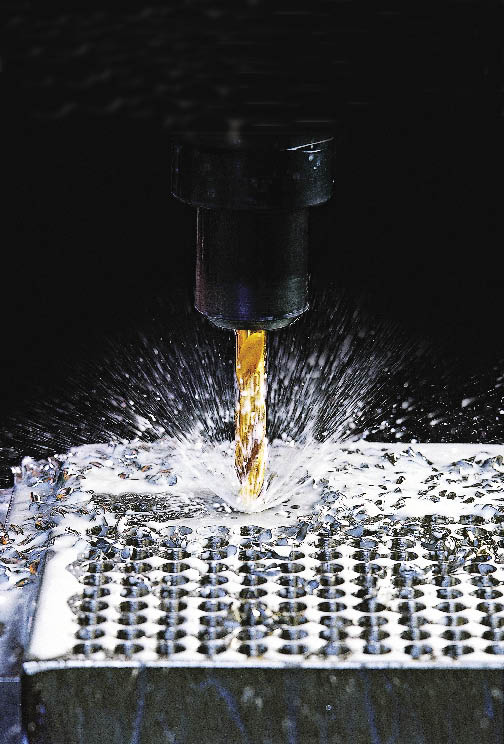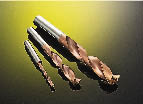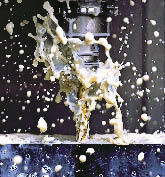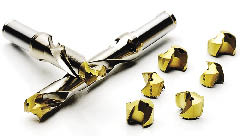Super Drills
Super Drills
Increasingly sophisticated drills enable shops to tackle nickel-based superalloys with ease.
More sophisticated drills enable shops to tackle superalloys with ease
No one can put as fine a point on how complex drilling has become during the past few decades than a veteran machinist like Peter Diamantis.
Diamantis recalled that when he started out 30 years ago drills held a status in the tooling hierarchy not unlike hammers: just about any one would do the job. "I remember when people would tell my plant manager they needed to drill stainless steel, and he would go into our stockroom, pick out a drill that we had too many of and sell them that," said Diamantis.


Courtesy of Sandvik Coromant
Sandvik Coromant's carbide drill for machining superalloy, the CoroDrill Delta-C, is designed specifically for aerospace and gas turbine applications.
Today, as plant manager for Amamco Tool, Greer, S.C., Diamantis' responsibilities include oversight of the company's various, and exacting, drilling operations. "Now," he said, "everything is so specific that you can be drilling the same material but if you're limited by your machine's capabilities, your setup or even such a subtle change as using different coolant, you will probably have to change your drill geometry to fit those specific needs. So drilling [then and now] is like night and day."
One reason for drilling's growing sophistication has been increasing demand for heat-resistant materials, such as the nickel-based superalloys (Inconel, Rene, Hastelloy, etc.) often used in aerospace applications. These high-priced metals pose numerous challenges. For one, their ability to withstand high temperatures means that the heat generated during drilling is transferred to the drill. Drills also are often used in difficult-to-reach areas, which puts a premium on effective toolholding solutions to ensure stability.
To maximize tool life and ensure success with superalloys, drilling experts are always on the lookout for ways to improve everything from coolant to toolholding, coating and geometry.
Drill Composition, Geometry
"The big issue [when drilling superalloys] is that you want a process that is reliable and provides component quality with a long, predictable tool life," said Thomas Sandrud, holemaking manager for Seco Tools Inc., Troy, Mich. "These are expensive workpiece materials that are difficult to machine due to the tendency of workhardening and the high cutting forces generated by the material, which [produces] a lot of heat and pressure. So it is important that the geometry of the drill is specially designed for drilling in superalloys. This means a free-cutting geometry that leads to less deformation hardening, reduces exit burrs and minimizes residual stresses."
How well a drill can machine superalloys consistently and accurately involves a variety of factors, starting with the workpiece. "Carbide drills are recommended whenever possible for increased wear and heat resistance in comparison to cobalt-HSS drills," said Bob Hellinger, national sales manager for Guhring Inc., Brookfield, Wis.
Hellinger also endorsed drills composed of submicrograin carbide. "For example," he said, "Guhring recommends a DK46OUF grade of carbide with a 0.5µm-grain size, which is one-fifth the grain size of conventional P40- or C5-grade carbide. The reduced grain size allows for sharper cutting edges after honing."
As for honing, Amamco's Diamantis suggested prepping the edge point on the drill tip to remove excessive sharpness. Overly sharp edges create microfractures that will prematurely chip and break, he said, adding that slightly dulling them strengthens the tool and allows machinists to feed more aggressively into the superalloys than they would otherwise.

Courtesy of Seco Tools
Seco Tools' feedMax solid-carbide drills provide a high feed up to 0.028 ipr.
To prep the edge on a point, Diamantis recommended using a very high-grit wheel or a honing stone. "If you have a CNC machine that can follow edges precisely, you can use an abrasive nylon wheel that is specifically designed to edge prep," he said, adding the cautionary that exceeding a 0.002 " width on the edge prep would diminish the effectiveness of the point geometry.
"To make the tip even stronger you can dub it, which is what I do when drilling superalloys like Inconel," continued Diamantis. "That involves grinding an angle of about 5° dead on the face of the drill tip. You can control the rake angle of the drill at the cutting point without affecting the rest of the helix angle."
Toolholding
Once the tool has been selected for a job, the next step is to make sure it's securely held in place to drill. Seco Tools recommends a shrink-fit system for holding the drills. What that involves, said Sandrud, is "the bore in which the tool locates is slightly undersized compared to the tool shank. Heating the holder opens up this bore, allowing the tool to be inserted. As the holder cools, the bore shrinks around the tool to create a concentric and rigid clamping. The shrink fit is the best clamping system when it comes to getting good runout, which is important to hole geometry and [extending] tool life," said Sandrud.
Another factor that gives added importance to effective toolholding is the constricted work area common in aerospace projects. Kevin McCall, solutions team leader for Sandvik Coromant Co., Fair Lawn, N.J., noted that the abundance of "overhang situations" present special challenges.
"A lot of superalloys are used in engine parts where you have to get down behind flanges or way out onto a rotary table to actually create features on the part," he said.
The toolholding solution, McCall said, is a hydromechanical chuck that clamps onto the tool shank. Sandvik's HydroGrip, for example, grips the tool completely and does not have a large diameter down near where the drill is being held, which allows the operator to work in hard-to-reach areas.
Also, the hydromechanical chucks provide low runout, said McCall. "Whereas when you use a collet, you can get an excessive amount of runout. I think the criterion you want to stick with is that if you get more than a 0.0005 " TIR, you're going to get very aggressive wear on the circular land, the outside of the drill. So one of the major challenges when drilling most of these superalloy materials is making sure that the tool is held very accurately."
Heat Issues
The biggest challenge end users face when drilling superalloys is how best to manage the resulting heat. Two prime considerations are drill coatings and coolants. "Titanium-based tool coatings are used extensively in the machining of superalloys," said Guhring's Hellinger. He added that coatings such as "titanium aluminum nitride and aluminum titanium nitride have an oxidation temperature that is over 300° F higher than titanium-nitride coating. These coatings form an amorphous layer of aluminum oxide that imparts greater heat and hardness at elevated temperatures, which are common in superalloy drilling."

Courtesy of Seco Tools
The CrownLoc drills from Seco Tools incorporate exchangeable crowns, which eliminates regrinding.
As for coolants, McCall at Sandvik Coromant prefers water-soluble, vegetable-based ones because they have few chemicals, which minimizes health hazards for machinists. "You also need a high concentration, at least a 10 percent mixture coolant," he said. "And the other aspect to this, which I don't think a lot of customers consider, is [through-tool] high-pressure coolant, at least 1,000 psi. The smaller the drill, the less volume you can get through that tool, and that [decreased volume] is the real enemy here. When you have a small drill, the heat at its tip is able to radiate through the entire drill very quickly. With high-pressure coolant, you're able to dissipate that heat and evacuate the chips quickly and efficiently. You're also less likely to have chips stick to the drill tip and then drag inside and score the hole."
McCall added that cooling efforts can quickly go awry when shops use the wrong toolholder for a tool, such as an unsealed ER collet chuck. If there are any leaks in the holder, water will find them.
"As the drill is engaged with the material, the through-coolant holes are partially plugged and so the coolant, under pressure, is going to find the path of least resistance," said McCall. "That is also why it is critical to have a drill with large enough flutes for effective chip and coolant evacuation, in conjunction with a suitable toolholder and machine [with through-spindle coolant]."
When problems do occur, they can be hard to detect. With coolant splashing everywhere, the operator might easily conclude that everything is as it should be. All the while, though, the drill tip is heating up.
"As a result, you can bind the tool right in the part and either snap it off, or sometimes the drill is strong enough that you could actually just push the material and blow the hole right out," said McCall. "Then, of course, the part is deviated."
Joe Nuzzi, director of product development at Allied Machine and Engineering Corp., Dover, Ohio, typically will start holes with a short drill, especially for deep cuts. He will then use a longer drill to finish the job.
"The deeper you go the more difficult it becomes," added Jim Porter, application engineering supervisor for Allied Machine and Engineering. "Obviously, as you go to the longer tools, we recommend increasing your coolant pressure to overcome resistance to chip evacuation. Generally, the other option is to reduce your penetration rate to create less chip volume to begin with so that you give the machine time to let the coolant do its job to evacuate chips."
Tool Life
Regardless of how effective the toolholding and coolant are, drills eventually wear down. But that's seldom a reason to toss them, said Diamantis, adding that many shops do so routinely.
The alternative, he said, is resharpening. "If they're not burned, you can sharpen them very minimally by removing about 0.030 " to 0.060 " of the overall length, and you have a brand-new drill."
When resharpening, continued Diamantis, it is important for regrind shops to remember to remove the drill's front taper that has formed as a result of wear. "It's critical that the very front of the tool is bigger than farther back. The drill should always have a back taper along the entire flute length. If you sharpen the tool correctly, you'll have a brand-new drill for a fraction of the cost you would otherwise pay."
While drill coatings, coolants and toolholding solutions might not have been priorities in past times, there's no question that ongoing refinements in materials will demand ongoing advances in drilling technology and techniques.
"Even 15 years ago, I used to think drilling was hard," said Diamantis. "But I look back today and I think that was easy. It's a completely different world."





